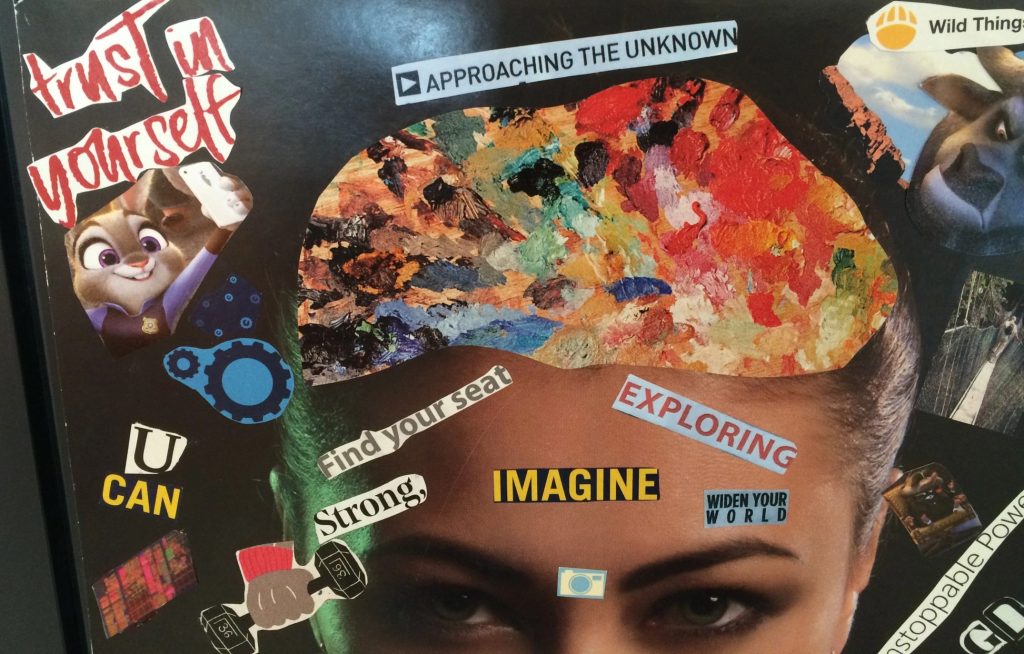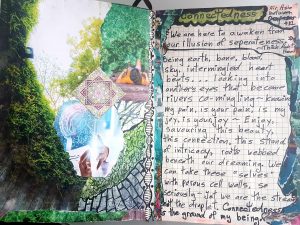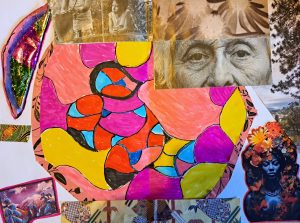10 Self Exploration Through Collage
“Images have a way of bypassing the chatter of our logical minds and nudging our deep soul wisdom.” –Soul Collage

Purpose:
Artistic expression can be intimidating to people who feel insecure about their creative abilities. Playing with collage materials breaks through those inhibitions as participants are using colours, images and words from magazines, posters, cards, photos or other printed materials to express their inner world. The purpose of collaging is to explore images and colours that express participants’ emotions, dreams and inner worlds.
Learning Objectives
Particpants will:
- Express emotions, fears, goals or dreams using images from print media or photos from their lives.
- Share with each other in small groups why they chose these images and what they mean to the creator.
Collage Cards:
This activity is loosely adapted from the “Soul Collage” process created by therapist Seena Frost. For more information about her formal process of creating soul collage decks of cards, refer to her book and website: soulcollage.com
Collage Identity Cards Activity Directions:
- Reflection: Hand out 5 by 7 index cards or cut cardstock paper to the size of large postcards. Lead individual or group in a short meditation where they explore the question “Who am I?” The following questions might help them access the visual imagery of their experience:
Exploration questions:
- What thoughts and emotions arise as you contemplate the question: “Who am I in this very moment?’
- Pay attention to the energy in your body and mind. If this energy was a colour, what colour would it be?
- Notice if there are thoughts or memories of your past or worries about your future. When they arise, gently notice them and come back to your present experience. Who am I right now? What do I hear, feel, experience in this moment?
- Are there any images that come to mind that represent how you feel right now. These might be colours, shapes, creatures, plants or anything else that is a symbol or your current experience.
2. Find Materials: Ask the group or individual to open their eyes and move to the table where the collage materials are laid out. Ask people to stay silent through this process so they are accessing the non-verbal parts of their brain. Let them choose colours and images that complete the phrase: “I am . . . . . . . . .”
3. Create Collage: Allow 20 to 30 minutes for participants to cut out images and glue them to their cards.
4. Write Reflections: As people complete their cards, ask them to turn them over and write on the back side of the card their reflection on what the card shows about their personal identity in this moment.
5. Small Group Discussion: In a class or group setting, have participants form groups of 3 – 4 and share their cards and describe their experience of exploring their identity through collage. Participants could also ask their group mates what they see in the card. What does it show them about the collage artist’s identity?
6. Full Group Discussion: Bring the full group back together and debrief with some of the following questions:
- What did you learn about yourself while creating your collage card?
- What did you learn about your group mates when sharing your cards?
- How do you feel about expressing yourself through art?
- What is it different about expressing yourself through art or through language?
- In what ways do you think collage is like a metaphor for life?

Reflections written on back of the card completing the sentence stem “I am ________ “
(the collage is like a dream revealing aspects of the collage artist’s present being)
“I am reaching for connection. I am the minaret and the Buddha who teach of generosity, integrity and peace. I am the tiny human held by the parachute wondering about my purpose in this life and wanting perspective. I want to look down on the ephemeral flowers and bubbles and flowing horses and feel gratitude for the small moments in life. I am the one who seeks beauty and some kind of pattern in the randomness of life.”
Extension Activities with Collage Cards
- Storytelling: With a small group you can use the collaged cards as a story telling activity. Place people’s personal collage cards face down in the middle of the group and mix them up so no one knows whose card they will be picking. Ask one person to pick a random card, reflect on it and start a story based on what they see in the card. The next person in the circle picks another card and continues the story until all the cards are used. Ask the group what it was like to have their personal collage spoken about by another person and how they felt about their card’s role in the group story.
- Writing: Combine collage with a writing activity. The following journal spread combines writing about an identified strength from a Clifton Strengths Assessment with collage images that help explore the personal meaning of this strength in the participant’s life.

- Neurographic Art: Neurographic art invites people to consider something in their life where they are seeking clarity. They then spend 3 seconds scribbling looping lines on the page as they consider their issue. After that, they round the corners of the sharp lines and fill in spaces with colours. As they are doodling, they are contemplating possible ways of handling an issue or dilemma. The theory is that the art frees up the mind to find novel approaches to personal conundrums. These neurographic pieces can form the center of a mandala where collage can be added for complementary images and meanings.

